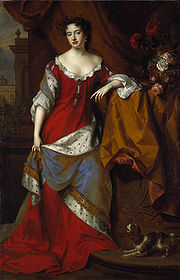Stuart period
.jpg) | | .jpg) | | .jpg)
James I Charles I Charles II  | | 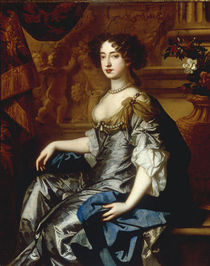 | | 
James II Mary II Anne |
|
| Preceded by | House of Tudor |
|---|---|
| Followed by | House of Hanover |
The Stuart period of British history usually refers to the period between 1603 and 1714 and sometimes from 1371 in Scotland. This coincides with the rule of the House of Stuart, whose first monarch was James VI of Scotland. The death of Queen Elizabeth I without any heirs, last of the Tudors, left England without any English King or Queen. The English were now ruled by a Scottish king. The regicide of King Charles I brought a temporary end to the rule by the Stuarts. England then became a Republic under Oliver Cromwell. The Stuarts were then restored to the throne under Charles II in 1660. The period ended with the death of Queen Anne and accession of George I from the House of Hanover. The Stuart era experienced many changes: a gunpowder plot, civil and naval wars, a glorious revolution, regicide of a king, a republic, the great plague, and a great fire in London. This was the era of Shakespeare, Wren, Galileo, Newton and Samuel Pepys to name but a few. The era saw the settlement of the Americas, trade with the Spice Islands, the birth of steam engines, microscopes, coffee houses and newspapers.
Contents |
Flags, coins and styles (1606–1707)
.jpg)
This James I proclamation of 12 April 1606 legislated an amalgamation of the English and Scottish flags, initiating the design of the current Union Flag.
about the bearing of their Flagges: For the avoiding of all contentions hereafter. We have, with the advice of our Council, ordered: That
from henceforth all our Subjects of this Isle and Kingdome of Great Britaine, and all our members thereof, shall beare in their main-toppe
the Red Crosse, commonly called St. George's Crosse, and the White Crosse, commonly called St. Andrew's Cross,
joyned together according to the forme made by our heralds, and sent by Us to our 'Admerall' to be published to our Subjects:
and in their fore-toppe our Subjects of South Britaine shall weare the Red Crosse onely as they were wont,
and our Subjects of North Britaine in their fore-toppe the White Crosse onely as they were accustomed. – 1606. [1][2]}}
.svg.png)
_2.jpg)
MAGNAE BRITANNIAE REX
| “ | The miraculous and happy Union of England and Scotland, by how 'admirable' means it is effected, how profitable to both nations, and how free of any inconvenience, either past, present, or to be discerned.[3] |
” |
James I was the first British monarch to use the style "King of Great Britain." [2] Non-statutory use of this style is found on heraldic and vexillogical symbolism, such as the king's Great Seals of Office, the Royal Arms, and coinage. The style "King of Great Britain" (MAGNAE BRITANNIAE REX) appears on all Great Seals instead of a more formally correct "king of England and Scotland" (ANGLIAE SCOTIAE REX) in 1625–1627, 1640–1649, 1660–1689, and 1695–1707. The coins of James I and his successors used MAGNAE BRITANNIAE REX, as seen on the half crown of Charles II. [4]
Lifestyles of the period
Social lifestyles
Many strictures were placed on society by the Puritans. Amongst other things, the Puritans banned gambling, cockfights, the theatre, and even Christmas. The arrival of Charles II brought relief from the warlike and strict society that people had lived in for several years. The theatre returned, along with expensive fashions such as the periwig. The British Empire had been expanding since the Elizabethian era, and along with much wealth returning to the country, expensive luxury items were appearing. Sugar and coffee from the East Indies, tea from India and slaves from Africa were all essential items forming the backbone of trade, becoming the basis of London society. One person in nine is estimated to have lived in London near the end of the Stuart period and, as a hub of trade, expensive goods from all over accumulated there. Coffee houses were becoming the centers of business and social life. Only coffee, tea and chocolate were served (no alcohol). Here news could be had, conversation, arguments, meetings, card games, wagers made, workmen could be paid. These products can be considered as beginning the consumer society which, while it promoted trade and brought development and riches to society, helped widen the gap between rich and poor. At the beginning of the Stuart period, James I authorised a new translation of the Bible known as the King James Bible or Authorised Version. This was an important event in clearly separating the Anglican and Catholic churches, just as the Book of Common Prayer had done fifty years earlier. As a standard text it was also a major influence on English literature, language and thought for centuries to come. Newspapers, a fairly new invention, soon became important tools of social discourse, and diarists such as Samuel Pepys are some of the best sources we have of everyday life in Restoration England.
Political society

The Stuart period was plagued by political, internal and religious strife. During the Interregnum there were two types of government: the Commonwealth and the Protectorate of Oliver Cromwell. Both these governments were based on the rule of the same class of gentry and wealthy merchants, who had formed the majority of the electorate to Parliament before the Civil War. The old ruling class faced challenges to their position by other sections of society. The most important of these were the Levellers, who wished to "level" society, removing class distinctions to make all men equal. They wished for universal suffrage for all adult male householders, regular elections and abolition of all tithes – which would break the power of the established church.
Public transport
Since 1600 public carriages for hire were a feature of London life. Travel by coach was the regular public transport, which filled the road with traffic. The discarded coaches of aristocratic families, complete with their coat of arms, were among the first hackney carriages to ply for hire. The first hackney-carriage licences date from 1662, and applied literally to horse-drawn carriages, later modernised as Hansom cabs (1834), that operated as vehicles for hire. This public transport was first introduced to England by Captain Bailey, who standardised fares and issued licences for London Hackney Carriage. Road signs and the first road atlas by John Ogilvy further revolutionised the transport system, and standardised the mile.
Science and technology
.png)
- The Fire Office of Nicholas Barbon led to the development of the first professional fire service.
- The seed drill allowed Jethro Tull to put his revolutionary new planting techniques into practice, leading to modern agriculture.
- The fountain pen was first mentioned in the diaries of Samuel Pepys and it allowed him to write on the move.
- Colourfast dyes were created in Britain’s first chemical works at Ravenscar when supplies of the mordant alum were cut-off.
- The three-piece suit and necktie were created by Charles II as a political weapon in his war against France.
- Properties of gases investigated by Robert Boyle and Richard Townley led to the invention of the pressure cooker.
- The steam engine was invented by Thomas Newcomen to drain water from the coalmines of the Midlands.
- The pendulum clock based on Galileo's principles was invented by Christiaan Huygens and led to the establishment of GMT.
- Lunar observations of John Wilkins based on the previous observations of Galileo challenged long held views of the heavens.
- Principia by Isaac Newton established three simple laws that revolutionised our view of the universe.
- The microscope as refined by Robert Hook and Antonie van Leeuwenhoek allowed the microscopic world to be viewed in detail.
- The diving bell as refined by Edmund Halley allowed the investigation of the depths of the ocean.
- The micrometer devised by William Gascoigne proved Johannes Kepler’s theories of elliptical planetary motion.
Literature and art
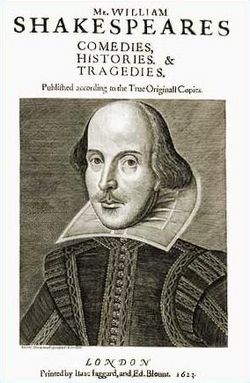
- William Shakespeare (1564–1616), English poet and playwright, is widely regarded as the greatest writer in the English language and the world's pre-eminent dramatist. He is often called England's national poet and the "Bard of Avon", producing most of his known work between 1589 and 1613. His early plays were mainly comedies and histories, genres he raised to the peak of sophistication and artistry by the end of the sixteenth century. He then wrote mainly tragedies until about 1608, including Hamlet, King Lear, and Macbeth, considered some of the finest works in the English language.
- John Speed (1552–1629) was a historian, best remembered as a cartographer. It was with the encouragement of William Camden that he began his Historie of Great Britaine, first published in 1611. His atlas The Theatre of the Empire of Great Britaine was published in 1610/11, and contained the first set of individual county maps of England and Wales, maps of Ireland, and a general map of Scotland. Just before his death in 1627 Speed published A Prospect of the Most Famous Parts of the World, which was the first world atlas produced by an Englishman. In 1611, he also published The genealogies recorded in the Sacred Scriptures according to every family and tribe with the line of Our Savior Jesus Christ observed from Adam to the Blessed Virgin Mary, a biblical genealogy, reprinted several times during the 17th century.[5]
Notable events
.jpg)
Gunpowder Plot (1605)
through a practise but that morning discovered. The plot was to have blown up the King at such time as he should have been set on his Royal Throne, accompanied with all his Children, Nobility and Commoners and assisted with all Bishops, Judges and Doctors; at one instant and blast to have ruin'd the whole State and Kingdom of England.
And for the effecting of this, there was placed under the Parliament House, where the king should sit,
some 30 barrels of powder, with good store of wood, faggots, pieces and bars of iron.
Extract of a letter from Sir Edward Hoby (Gentleman of the Bedchamber) to Sir Thomas Edwards, Ambassador at Brussells [sic][6]
English Civil War (1642–1651)
The English Civil Wars, also known as the Wars of the Three Kingdoms, took place in the reign of Charles I, the second Stuart monarch. This ended in victory for the Parliamentarians under Oliver Cromwell, when Charles I was executed in 1649. After this conflict the line of Stuart monarchs was temporarily displaced by the Commonwealth of England (1649–1660). This was ruled directly by Oliver Cromwell (1653–1659). After Cromwell's death the Commonwealth fell apart and the Convention Parliament welcomed Charles II, who returned from exile to become king. This is known as the English Restoration.
Interregnum – Restoration (1651–1660)
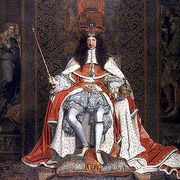
- Timeline
(1652): First Anglo-Dutch War begins (ends 1654). (1653): Cromwell disolves Rump, becomes Protector. (1655): Major-Generals appointed to supervise districts of England. Jamaica seized by English. (1658): Death of Cromwell. (1660): Restoration of Charles II in Britain. (future) George I born in Hanover. Royal Society founded. (1661): "Clarendon Code" beginning of persecution of Non-conformists in England. (1664): New York taken by English. Second Anglo-Dutch War (ends 1667). (1665): Great Plague of London. (1666): Great Fire of London. Newton discovers law of gravitation. (1667): Dutch Fleet in the Medway. (1670): Secret treaty of Dover between Charles II and Louis XIV. (1672): Third Anglo-Dutch Wars (ends 1674). William of Orange leader of Dutch against French invasion. (1673): Test Act deprives Catholics and Non-conformists of public offices. (1675): Greenwich Royal Observatory founded. (1678): "Popish Plot" of Titus Oates utilised by Shaftsbury and Whigs to bring pressure on Charles II. (1679): Bothwell Brig: suppression of Scottish Convenanters. Habeas Corpus Act passed. (1681): Oxford Parliament (1681): Charles II overcomes opponents begins to rule without Parliament. (1683): Rye House Plot. (1685): Sedgemoor: Monmouths rebellion crushed by James II. Glorious revolution (1688)
Great Plague of London (1665)
The Great Plague (1665–1666) was a massive outbreak of bubonic plague in the Kingdom of England that killed an estimated 100,000 people, 20% of London's population.[7] In 1603, the plague killed 30,000 Londoners.[8] In the 1636 plague 10,000 died; in 1625, some 35,000 died.[9] The English outbreak is thought to have spread from the Netherlands, where the bubonic plague had occurred intermittently since 1599, with the initial contagion arriving with Dutch trading ships carrying bales of cotton from Amsterdam. Amsterdam was ravaged in 1663–1664, with a mortality given as 50,000.[10] The dock areas outside of London, and the parish of St. Giles-in-the Fields where poor workers crowded into ill-kept structures, were the first areas struck by the plague. On 2 and 3 September 1666, the Great Fire of London destroyed much of the City of London. At about the same time, the plague tapered off.

Great Fire of London (1666)
Following the Great Fire of London, the notable architect Sir Christopher Wren (1632–1723), introduced Neo-classical architecture to London, and was one of the highest acclaimed English architects in history, responsible for rebuilding 51 churches in the City of London after the Great Fire in 1666, including his masterpiece, St Paul's Cathedral, completed in 1710.
Glorious Revolution (1688)
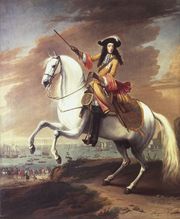
- Timeline
(1688): Seven Bishops protest against James II's policy of tolleration, and are acquitted, William of Orange lands in England. Flight of James II. "Glorious Revolution". (1689): Derry relieved: James II fails to subdue Irish Protestants. Killiecrankie: death of Dundee, Highland rising collapses. Bill of Rights defines liberties established by "Glorious Revolution." (1690): Beachy Head: French defeat over Anglo-Dutch fleet. Boyne: William III defeats James II. (1691): Limerick capitulates: James II Irish supporters surrender. (1692): Massacre of Glencoe: Government "lesson" to Highlanders. (1693): National Debt of England begun. (1694): Bank of England founded. (1695): Press licensing ended: Freedom of the press in England. (1700): Great Northern War (1700–1721) (1701): War of the Spanish Succession begins. Act of Settlement 1701 establishes Protestant Hanoverian Succession in England. (1704): Gibraltar taken by Rooke. Blenheim: Marlborough stops France from winning war. (1706): Ramillies: Marlborough's second victory.
Acts of Union (1707)
(1707): Act of Union unites English and Scottish Parliaments. (1708): Oudenarde: Marlboroughs third great victory. (1709): Malplaquet: Marlboroughs fourth great victory (at great cost in lives) (1710): Tory government in England. (1711): Dismissal of Marlborough. (1714): Death of Queen Anne. Accession of George I, and Hanoverian Dynasty. Whig oligarchy rules.
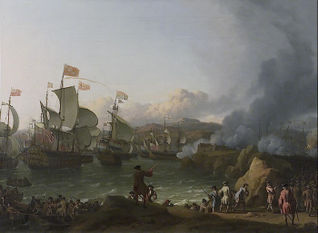
|
|||||
upon the Ist day of May next ensuing the date hereof, and for ever after,
be united into one kingdom by the name of Great Britain,
and that the ensigns armorial of the said United Kingdom be such
as Her Majesty shall appoint,
and the crosses of St. Andrew and St. George be conjoined in such manner
as Her Majesty shall think fit,
and used in all flags, banners, standards and ensigns, both at sea and land.
Stuart family Monarchs (1603–1714)
The House of Stuart produced six English monarchs who ruled during this period. The succession of James VI of Scotland to the English throne in 1603, brought both the kingdoms of England and Scotland under his rule, in what was known as the Union of Crowns. Over a century later, the Acts of Union 1707, passed during the reign of the last Stuart monarch, Anne, amalgamated the two kingdoms, England and Scotland, into a single Kingdom of Great Britain.
 |
.jpg) |
|---|---|
.jpg) |
 |
 |
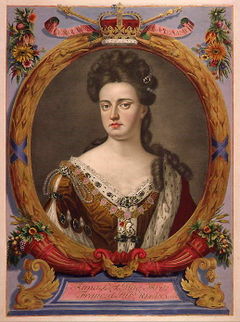 |
 |
 |
|---|---|
 |
 |
 |
 |
King James I (1603 to 1625). Son of Mary Queen of Scots and Henry Stuart, Lord Darnley. King of Scotland alone, 1567–1603, until inheriting the titles King of England and Ireland, including claim to France from the extinct Tudors.
King Charles I (1625 to 1649). Son of James VI of Scotland & I of England & Ireland. After the English Civil War, Charles I was executed in 1649. The country then became a Republic under Oliver Cromwell, until the restoration of Charles II in 1660.
King Charles II (1660 to 1685). Son of Charles I of England, Scotland & Ireland. In exile from 1649 to 1660, during a republican period of government known as the Commonwealth of England.
King James II (1685 to 1688). Brother of Charles II of England, Scotland & Ireland, who died with no legitimate issue. Son of Charles I. Overthrown at the Revolution of 1688.
Queen Mary II (1689 to 1702). Daughter of James II of England and Ireland & VII of Scotland, (deemed as having abdicated). Reigned with William III of House of Orange-Nassau. who outlived his wife.
Queen Anne (1702 to 1714). Sister of Mary II. daughter of James II of England and Ireland & VII of Scotland. Died without surviving issue, succession passes to George I of the House of Hanover.
See also
- House of Stuart
- Kingdom of England
- Kingdom of Scotland
- Jacobitism, for further information on the House of Stuart and their decline
- The family trees of the Stuarts: Scottish branch – England and Scotland united
- Clan Stuart
External links
|
|||||
|
|||||
|
|||||
|
|||||
- What the Stuarts Did for Us at the Internet Movie Database
- Proclamation styling James I King of Great Britain on October 20, 1604
- The Calendar of State Papers Domestic: James I, 1603–1610
- Works by James I of England at Project Gutenberg
- Stewart Scotland on the official website of the British monarchy
- Stuart Britain on the official website of the British monarchy
- Jacobites on the official website of the British monarchy
References
- ↑ Fox-Davies, Arthur Charles (1904 & 1986). The Art of Heraldry – An Encyclopaedia of Armory. London: Bloomsbury Books. p. 399. ISBN 0906223342.
- ↑ 2.0 2.1 http://www.flaginstitute.org/index.php?location=7
- ↑ CSPD [Imprinted for Edward Blount] Volume 10: November–December, 1604, pp. 164–182.
- ↑ http://www.archontology.org/nations/uk/england/king_england/01_kingstyle_1604.php
- ↑ The Counties of Britain. John Speed (1995) ISBN 1857936124.
- ↑ Nichols 1828, p. 584
- ↑ The London Plague 1665
- ↑ London and the Great Plague of 1665
- ↑ The Great Plague of 1665
- ↑ E. Social, economic, and political impacts of the plague on Eurasia and Africa, New York State Education Department
- ↑ "Richard II". William Shakespeare. http://www.users.waitrose.com/~uk1/shakespeare/sceptred.htm. Retrieved 2009-09-05.
- ↑ Site Record for Glenfruin, Auchengaich; Glen Fruin; Battle Of Glen Fruin, Royal Commission on the Ancient and Historical Monuments of Scotland, http://canmore.rcahms.gov.uk/en/site/41400/
|
House of Stuart
|
||
| Preceded by House of Bruce |
Ruling house of the Kingdom of Scotland 1371–1649 |
Vacant |
| Preceded by House of Tudor |
Ruling house of the Kingdom of England 1603–1649 |
Vacant |
| Vacant | Ruling house of the Kingdom of Scotland 1660–1707 |
Titles merged by the Acts of Union 1707 |
| Vacant | Ruling house of the Kingdom of England 1660–1707 |
|
| New title England and Scotland united
|
Ruling house of the Kingdom of Great Britain 1606–1714 |
Succeeded by House of Hanover |
|
||||||||||||||||||||||||||
|
|||||||||||||||||||||||||||||||||||||||||||||||||||||||||||||||||||||||||||||||||||||||||||||||||||||||||||||||||||||||
